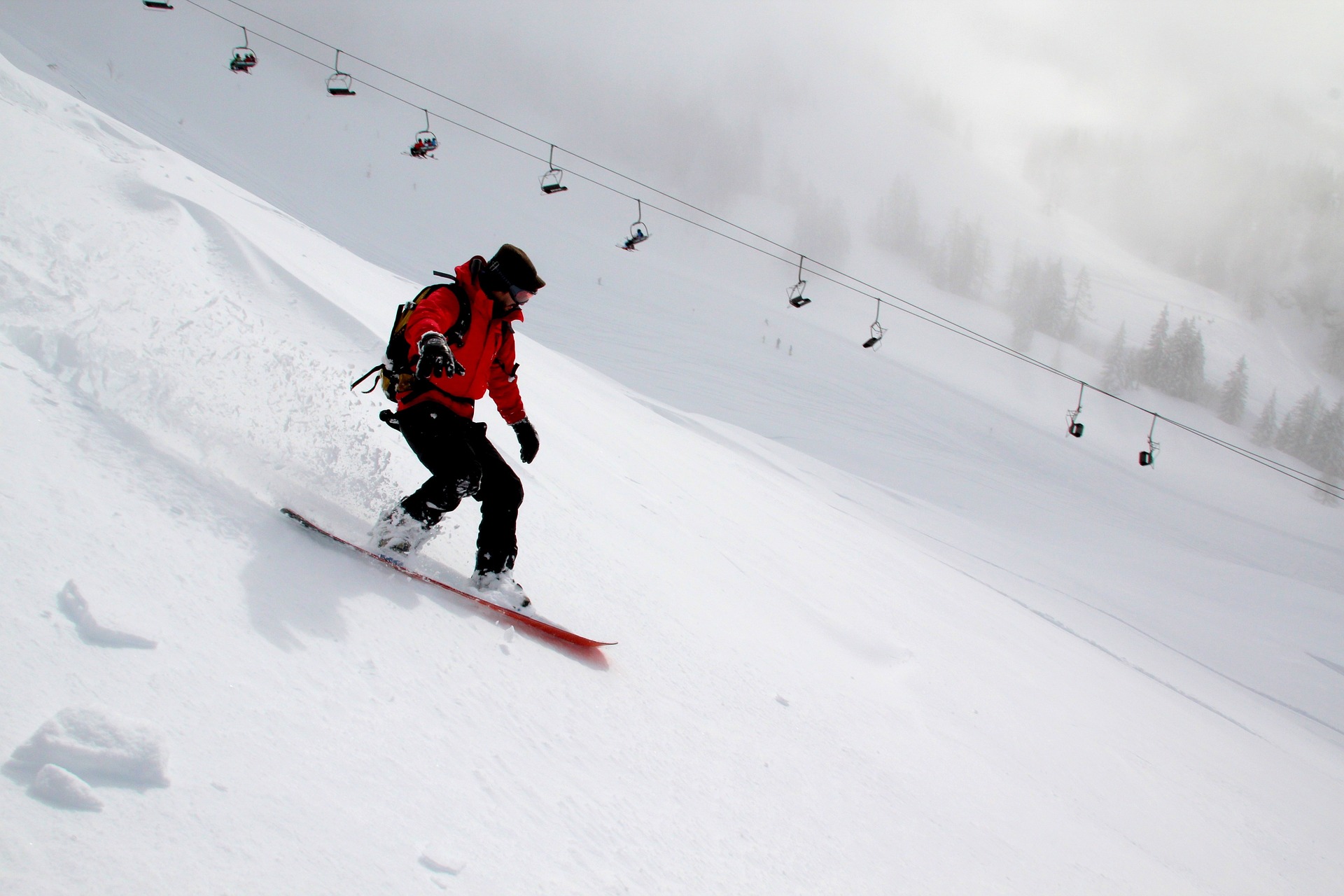If you grew up in a place where snow falls regularly during the winter months, you can probably remember standing at the top of a snow-covered hill of some sort and sliding down the incline. It may have been a big mountain, a small hill, or even a mound of snow made from the snowplow. You may have been on a sled, skis, a shovel, or just your feet or backside. That small, fun-filled action can be directly linked to the sport of snowboarding. Snowboarding, especially in the Midwest, is an extremely popular alternative to skiing. It’s quite the rush to carve down a hill or mountain, the wind whipping against your face. What many may not realize is that the sport can be traced directly back to West Michigan, and the grandfather of snowboarding, Sherman Poppen.
Sherman Poppen’s Early Years
In 1965, engineer and father Sherman Poppen didn’t intend to invent a prototype that would eventually give way to the modern snowboard. Let alone, a whole new sport. He was born in Muskegon, Michigan, on March 25, 1930. His father was a lawyer, and the city’s attorney. His mother was a school principal who later became a homemaker. As a young man, Sherman stood on the sand dunes looking out onto Lake Michigan and wishing he could surf. I imagine that this simple act was a contributing factor to his inspiration for the design of the SNURFER!
Sherman graduated from Muskegon High School, then Northwestern University on a full-ride NROTC Naval Scholarship. He graduated with a degree in business. Then he served in the US Navy as a supply officer on the USS Perry. After his tour of duty, he came back to Muskegon where he worked for the Lake Welding Supply Company. He eventually bought the company and turned it into a successful local business.
Throughout his life, as evidenced by serving in the Navy, Sherman was fascinated with water and ships. In fact, he had a special affinity for sailboats. He skippered two of his own vessels, both named Helza, which is short for Hellzapoppin’, a popular 1940s musical. He was a regular at the Muskegon Yacht Club, where he could often be found racing and chatting with friends and other sailors. However, his real claim to fame came during the winter of 1965.
The Big Idea
It was Christmas day. His wife, Nancy, was nine-months-pregnant, and his two daughters were getting cabin fever in their small home near Lake Michigan. Nancy asked Sherman to bring the girls outside and entertain them. The girls, 10-year-old Wendy, and 5-year-old Laurie, wanted to sled down the snow-covered dunes overlooking Lake Michigan near their home. The snow was too thin and the runners of the sled kept getting stuck in the sand underneath. Sherman had always pictured the dunes as a permanent wave. While watching his daughters, an idea formed in his mind.
He took a pair of the children’s blister-packed wooden skis from the dime store and fastened them together with pieces of wood on the top, allowing more flotation on the snow. It worked fairly well and the girls loved the new invention. Nancy dubbed the invention a Snurfer because it was like a combination of surfing and sledding in the snow. She gave birth to a third daughter, Julie, just three days later. The new winter sled became popular not only with Wendy and Laurie but also with their friends.
Sherman suspected he may be on to something with the Snurfer. He improved the design by taking a single water ski with grips and his father gave him the idea of attaching a tether to help steer. Sherman applied for a patent on the board in 1966 and received it in 1968. He always thought of the Snurfer as a piece of equipment for a new sport that incorporated surfing, skateboarding, and slalom water skiing.
Brunswick Broadens Snurfer Audience
The local invention quickly attracted the attention of Brunswick, a sports equipment manufacturer that specializes in billiards and bowling. Brunswick was starting a new consumer product division and this would work well as a new retail item. The company executives observed a film demonstration of the prototype by Wendy on the dunes behind the cottage, and then watched her in person. Some even tried the snurfer themselves. They saw its potential.
By the following Christmas, Brunswick began distributing the snurfer nationwide through another local store, the Cee-J Wholesale Toy Company. The Sears Catalog sold it for $6.88. There is much debate on how well they marketed the product since they sold it as a novelty item instead of sporting equipment. The initial model was painted yellow wood, with foot grips, and made from the same laminated wood that Brunswick used for their bowling alleys.
The official product was also wider and shorter than the original pair of children’s skis. Over one million Snurfers sold by 1970. However, in 1973, with declining sales partially due to marketing, Brunswick sold the rights to the JEM Corporation. It continued production and sales of the Snurfer to use not just as a recreational sport, but also as a competitive sport.
Competitive Snurfing Begins
The first competition for Snurfing was held at Blockhouse Hill in Muskegon State Park and organized by Muskegon Community College in February 1968. More than 300 people participated in the competition. Muskegon’s Ted Slater and Sally Waite won the event. Snurfing soon became a worldwide sport with contests being held across the United States, Canada, and Europe. The first National Snow Surfing Championship was held in Vermont in 1982.
In December of 1968, 14-year-old Jake Burton Carpenter of New York begged for a surfboard, but received a desk instead for Christmas. Consequently, he used his own money to buy a Snurfer for $10 and spent a lot of time at the local sledding hill on Long Island with his friends. He also started tinkering with the design of the board. He loved the sport so much that he would come to West Michigan for competitions as well as other locations. This young man would go on to found the Burton Snowboarding Company.
Poppen Dubbed Grandfather of Snowboarding
Sherman Poppen made a huge impact on many other snowboarding pioneers as well, including Tom Sims. Sims became a world snowboarding champion, and Poppen is now fondly known as the grandfather of snowboarding. Though initially, skiers and ski resorts did not like snowboarders on the slopes they eventually acquiescenced and snowboarding became a mainstream sport. It continued to grow, and became an Olympic winter sport, with the first competition held in Nagano, Japan in 1998.
Throughout his life, Sherman Poppen was known as a man who spent much of his time and fortune helping others and serving his community. He was a man of high moral and ethical integrity, with a sharp mind and wit. Described as a “can-do” person, Poppen liked solving problems. He worked hard, played hard, and enjoyed an occasional practical joke. He was also known as a good leader and served on the Norton Shores Planning Commission. Sherman and his sister, Leila founded the Leila and Cyrus Poppen Hospice Residence in Fruitport Township in honor of their parents.
Sadly, in 1993, Sherman’s wife Nancy Poppen died. He decided to memorialize her, and her love for the arts, with the Nancy K. Poppen Fund at the Community Foundation for Muskegon County. This initiative has gone on to provide individualized art opportunities for more than 2,000 low-income Muskegon Public Schools students. Through the fund, students can access music lessons, visual arts classes, and creative writing classes, or receive funding to attend dance or theater classes at local institutions.
Poppen’s Final Years
In the late 1990s, Sherman decided to retire from LWSC and sold the company back to his employees. After retiring, he and his new wife, Louise, moved out to Steamboat Springs, Colorado. It was here that he took up snowboarding at the age of 65, and quickly became known as the old man who could shred the slopes
Sherman’s impact on the sport of snowboarding did not go unnoticed. In 2001, he was inducted into the Muskegon Area Sports Hall of Fame, and in 2012, was received into the Muskegon Lakeshore Chamber of Commerce Business Hall of Fame. He was also inducted into the Banffs Snowboarding Hall of Fame in 1997. There is even a large sculpture in downtown Muskegon called The Turning Point, which is beautifully designed to commemorate Muskegon winter sports history and Sherman’s contribution to it. Today, several prototypes are preserved in the Smithsonian’s National Museum of American History and he was posthumously inducted into the US Ski and Snowboarding Hall of Fame in March 2020. The Smithsonian Magazine called the invention of the Snurfer the most important event in snowboarding history.
Sherman Poppen died on July 31, 2019, in Griffin, Georgia. It is believed he died from stroke complications. The popularity of Snurfing has faded away, due to newer designs in snowboards. Yet snurfing continues to be an iconic winter sport. In fact, snurfers can still be purchased today, mostly for backyard snowboarding. Beginners to experts can enjoy the product that is now made in Vermont. You can even buy racing models. If you want fast fun on those snow-covered hills and like some nostalgia, remember Sherman Poppen and try out a Snurfer.







Leave A Comment
You must be logged in to post a comment.